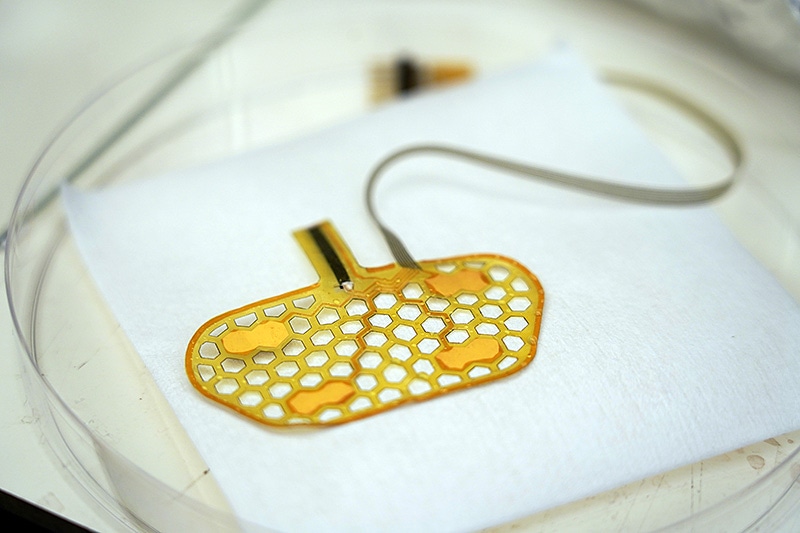Dec 18 2019
A wearable monitoring device with the ability to simplify treatments and make them more affordable for several million people suffering from swallowing disorders will soon hit the market.
 Purdue researchers created wearable technology to help people with swallowing disorders. Image Credit: Jared Pike/Purdue University.
Purdue researchers created wearable technology to help people with swallowing disorders. Image Credit: Jared Pike/Purdue University.
Curasis LLC was founded by Georgia A. Malandraki, an associate professor of speech, language, and hearing sciences in Purdue University’s College of Health and Human Sciences, and Chi Hwan Lee, an assistant professor of biomedical engineering and mechanical engineering in Purdue’s College of Engineering, who are the acting chief executive officer and chief technology officer of the company, respectively.
The company was launched to commercialize the wearable technology developed by the researchers and take it to clinics and people suffering from swallowing difficulties, as quickly as possible. The technology has been described in the December 13th issue of Science Advances.
We want to provide a reliable, patient-friendly and affordable way to treat the millions of people with swallowing disorders. Many devices to help these people are expensive, not able to be taken home and not accessible in many rural areas.
Georgia A. Malandraki, Associate Professor of Speech, Language, and Hearing Sciences, College of Health and Human Sciences, Purdue University
The scientists developed a skin-mountable sensor sticker that binds firmly to the neck area and is connected to a wireless transmitter unit through small cables. The sensor sticker quantifies and records movement and muscle activity that result from swallowing. Then, the information is wirelessly sent to a software by an individual unit attached to the wearer’s shirt. The software stores the information for subsequent analysis by a doctor.
To successfully carry out a swallow, accurate coordination of over 30 pairs of muscles of the head and neck, intricate circuitry in the brainstem and several areas of the brain, and six pairs of cranial nerves is crucial. If there is any disruption in these pathways, it can lead to acute swallowing disorders. In the United States, every year, over 9 million adults and 500,000 children experience acute swallowing disorders.
Our device is unique in that we specifically created it to work well with the small and intricate muscles associated with swallowing events. The sensor sticker is stretchable and flexible to work well with the skin and curvilinear head and neck shape, while the connected unit has electronic chips and more rigid components.
Chi Hwan Lee, Assistant Professor of Biomedical Engineering and Mechanical Engineering, College of Engineering, Purdue University
The disposable skin-mountable sensor stickers have been developed using low-cost components and are intended for use about 10 times before they are disposed.
Pre-clinical tests of the device have been completed by Malandraki and Lee, who are now conducting clinical trials. They are collaborating with the Purdue Research Foundation Office of Technology Commercialization on patenting their technology. They are also looking for more partners.
Moreover, they have worked in close collaboration with the Purdue Foundry, a commercialization hub in Purdue’s Burton D. Morgan Center for Entrepreneurship. Anne Smith, who retired as a distinguished professor in speech, language, and hearing sciences, is a senior advisor to the Curasis group.
Wearable Device to Assist Swallowing Disorders
Video Credit: Purdue University.